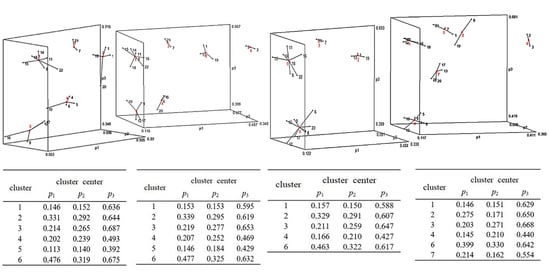Energy System Monitoring Based on Fuzzy Cognitive Modeling and Dynamic Clustering
Abstract
:1. Introduction
2. Problem Statement of Energy System Monitoring
- The set of ESs objects is considered:
- These ESs objects are connected by fuzzy impact relations with all other ESs objects:
- There are indicators based on fuzzy impact relations between ESs objects:
- With a given frequency, the monitoring of fuzzy impact relations R between ESs objects from the A is performed, then the values of fuzzy impact relations are actualized.
- To justify the indicators based on the fuzzy impact relations between ESs objects and allowing the estimation of the conformity of these ESs objects to different clusters;
- To design a model to, firstly, analyze the fuzzy impact relations between ESs objects and identify ESs clusters and, secondly, estimate the accordance degree of ESs objects with clusters based on the indicators values from a justified set;
- To propose a method based on the developed model, which allows the evaluation of the stability and monitoring cluster dynamics.
3. Analysis of Fuzzy Impact Relations between Objects and Identification of Energy System Clusters
- Firstly, the concepts can correspond to the ESs objects;
- Secondly, the concepts can correspond to the ESs objects of some initially formed cluster .
- The impact indicator of one ESs object on another ESs object;
- The mutual positive impact indicator of ESs objects on each other;
- The mutual negative impact indicator of ESs objects on each other;
- The indicator of the impact consonance of one ESs object on another ESs object;
- The indicator of the impact dissonance of one ESs object on another ESs object;
- The indicator of the mutual impact consonance of ESs objects on each other;
- The indicator of the mutual impact dissonance of ESs objects on each other;
- The impact indicator of a separate ESs object on clusters as a whole;
- The impact indicator of clusters on a separate ESs object;
- The indicator of the impact consonance of a separate ESs object on clusters;
- The indicator of the impact dissonance of a separate ESs object on clusters;
- The indicator of the impact consonance of clusters on a separate object of the ESs;
- The indicator of the impact consonance of clusters on a separate object of the ESs and the impact dissonance of clusters on a separate object of the ESs;
- The indicator of the impact consonance of clusters on a separate object of the ESs and the mutual consonance of a separate ESs object and ESs clusters;
- The indicator of the impact consonance of clusters on a separate object of the EsS and the mutual dissonance of a separate ESs object and ESs clusters.
- The impact indicator of a separate ESs object on clusters as a whole
- The impact indicator of clusters on a separate ESs object
- The indicator of the impact consonance of a separate ESs object on clusters
- The choice of indicators for identifying ESs clusters;
- Preliminary clustering of objects and identification of ESs clusters;
- Preliminary analysis of the ESs clusters’ stability.
4. Monitoring the Dynamics of Changes in the Energy System Cluster Structure
- Firstly, in the analysis of changes in the ESs cluster structure, including the analysis of the cluster centers’ drift, the disappearance and appearance of new clusters, their unification and separation;
- secondly, in the analysis of the ESs clusters stability based on the assessment of the results of transitive closure of fuzzy impact relations between ESs objects.
5. An Example of Monitoring the Dynamics of Changes in Energy System Clusters
| c1: {a1, a13, a19, a20}; | c2: {a7, a21}; | c3: {a2, a3}; |
| c4: {a4, a5, a6, a10, a12, a17}; | c5: {a8, a11, a14, a15, a18, a22}; | c6: {a9, a16}. |
- By the moment of time t = 1, object a10 moves out of the cluster c4 into the cluster c5, object a16—from the cluster c5 into the cluster c1, object a20—from the cluster c2 into the cluster c4; the drift of the centers of all clusters is noticeable, while the c5 cluster center drifts to the greatest extent;
- By the moment of time t = 2, cluster c4 and cluster c5 unite;
- By the time t = 3, object a1 moves into the cluster c3, object a8—into the cluster c2; a new cluster c7 appears, consisting of objects {a13, a17, a20, a22};
- By the time t = 4, the object a19 also moves into the cluster c7.
6. Conclusions
Author Contributions
Funding
Conflicts of Interest
References
- Savaget, P.; Geissdoerfer, M.; Kharrazi, A.; Evansa, S. The Theoretical Foundations of Sociotechnical Systems Change for Sustainability: A Systematic Literature Review. J. Clean. Prod. 2019, 206, 878–892. [Google Scholar] [CrossRef]
- Borrás, S.; Edler, J. The Governance of Socio-Technical Systems: Explaining Change; Edward Elgar Publishing: Cheltenham, UK, 2014. [Google Scholar]
- Nemtinov, V.; Zazulya, A.; Kapustin, V.; Nemtinova, Y. Analysis of Decision-Making Options in Complex Technical System Design. J. Phys. Conf. Ser. 2019, 1278, 012018. [Google Scholar] [CrossRef] [Green Version]
- Tkachenko, K. Ensuring the Computer Security of a Node by its Parametric Adjustment under Resource Constraints. Prikl. Inform. J. Appl. Inform. 2020, 15, 91–98. [Google Scholar] [CrossRef]
- Kychkin, A.V.; Mikriukov, G.P. Applied Data Analysis in Energy Monitoring System. Probl. Energ. Reg. 2016, 2, 84–91. [Google Scholar]
- Gibadullin, A.A.; Erygin, Y.u.V.; Polyakov, A.E.; Pobyvaev, S.A. Monitoring the Technical and Technological State of Electric Power Complex Facilities. In IOP Conference Series: Materials Science and Engineering, Proceedings of the II International Conference “MIP: Engineering-2020: Modernization, Innovations, Progress: Advanced Technologies in Material Science, Mechanical and Automation Engineering”, Krasnoyarsk, Russia, 16–18 April 2020; IOP Publishing: Bristol, UK, 2020; Volume 862. [Google Scholar]
- Ceschin, F.; Gaziulusoy, I. Evolution of Design for Sustainability: From Product Design to Design for System Innovations and Transitions. Des. Stud. 2016, 47, 118–163. [Google Scholar] [CrossRef]
- Geels, F.W. Ontologies, Socio-Technical Transitions (to Sustainability), and the Multi-Level Perspective. Res. Policy 2010, 39, 495–510. [Google Scholar] [CrossRef]
- Martin, B.R. The Evolution of Science Policy and Innovation Studies. Res. Policy 2012, 41, 1219–1239. [Google Scholar] [CrossRef] [Green Version]
- Angstenberger, L. Dynamic Fuzzy Pattern Recognition with Applications to Finance and Engineering; Kluwer Academic Publishers: Boston, MA, USA, 2001. [Google Scholar]
- Borisov, V.; Kurilin, S.; Prokimnov, N.; Chernovalova, M. Fuzzy Cognitive Modeling of Heterogeneous Electromechanical Systems. Prikl. Inform. J. Appl. Inform. 2021, 16, 32–39. [Google Scholar] [CrossRef]
- Ledneva, O.V.; Tsypin, A.P. Problems of Dynamic Modeling of Residential Buildings Commissioning in Post-Soviet Countries. Prikl. Inform. J. Appl. Inform. 2021, 16, 40–51. [Google Scholar] [CrossRef]
- Kosko, B. Fuzzy Cognitive Maps. Int. J. Man-Mach. Stud. 1986, 24, 65–75. [Google Scholar] [CrossRef]
- Thulukkanam, K.; Vasuki, R. Two New Fuzzy Models Using Fuzzy Cognitive Maps Model and Kosko Hamming Distance. Ultra Sci. 2015, 27, 43–55. [Google Scholar]
- Carvalho, J.P.; Tome, J.A.B. Rule Based Fuzzy Cognitive Maps in Socio-Economic Systems. IFSA-EUSFLAT 2009, 2009, 1821–1826. [Google Scholar]
- Borisov, V.; Fedulov, A. Generalized Rule-Based Fuzzy Cognitive Maps: Structure and Dynamics Model. In International Conference on Neural Information Processing; Springer: Berlin/Heidelberg, Germany, 2004; pp. 918–922. [Google Scholar]
- Silov, V. Strategic Decision-Making in Fuzzy Environment; INPRO-RES: Moscow, Russia, 1995. [Google Scholar]
- Geva, A.B.; Steinberg, Y.; Bruckmair, S.; Nahum, G. A Comparison of Cluster Validity Criteria for a Mixture of Normal Distributed Data. Pattern Recognit. Lett. 2000, 21, 511–529. [Google Scholar] [CrossRef]
- Borisov, V.; Dli, M.; Zaenchkovsky, A.; Fedulov, Y. Method for Identification, Stability Analysis and the Dynamics Monitoring of Sociotechnical Clusters. J. Phys. Conf. Ser. 2020, 1553, 012018. [Google Scholar] [CrossRef]
- Kaufman, L.; Rousseeuw, P.J. Finding Groups in Data. In An Introduction to Cluster Analysis; John Wiley & Sons Inc.: Hoboken, NJ, USA, 2005; pp. 83–102. [Google Scholar]
- Bezdek, J.C.; Keller, J.; Krisnapuram, R.; Pal, N. Fuzzy Models and Algorithms for Pattern Recognition and Image Processing; Springer Science: New York, NY, USA, 2005. [Google Scholar]
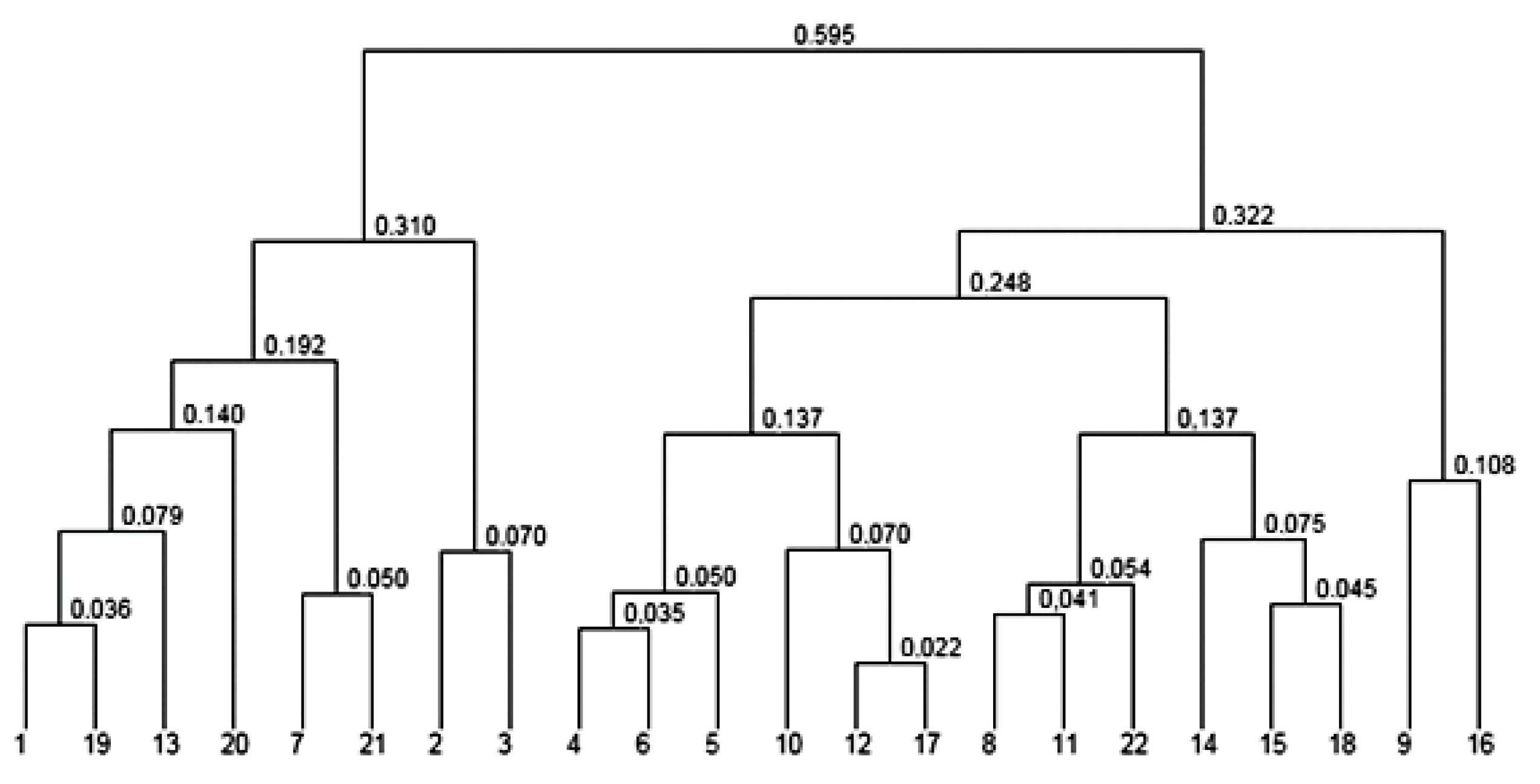
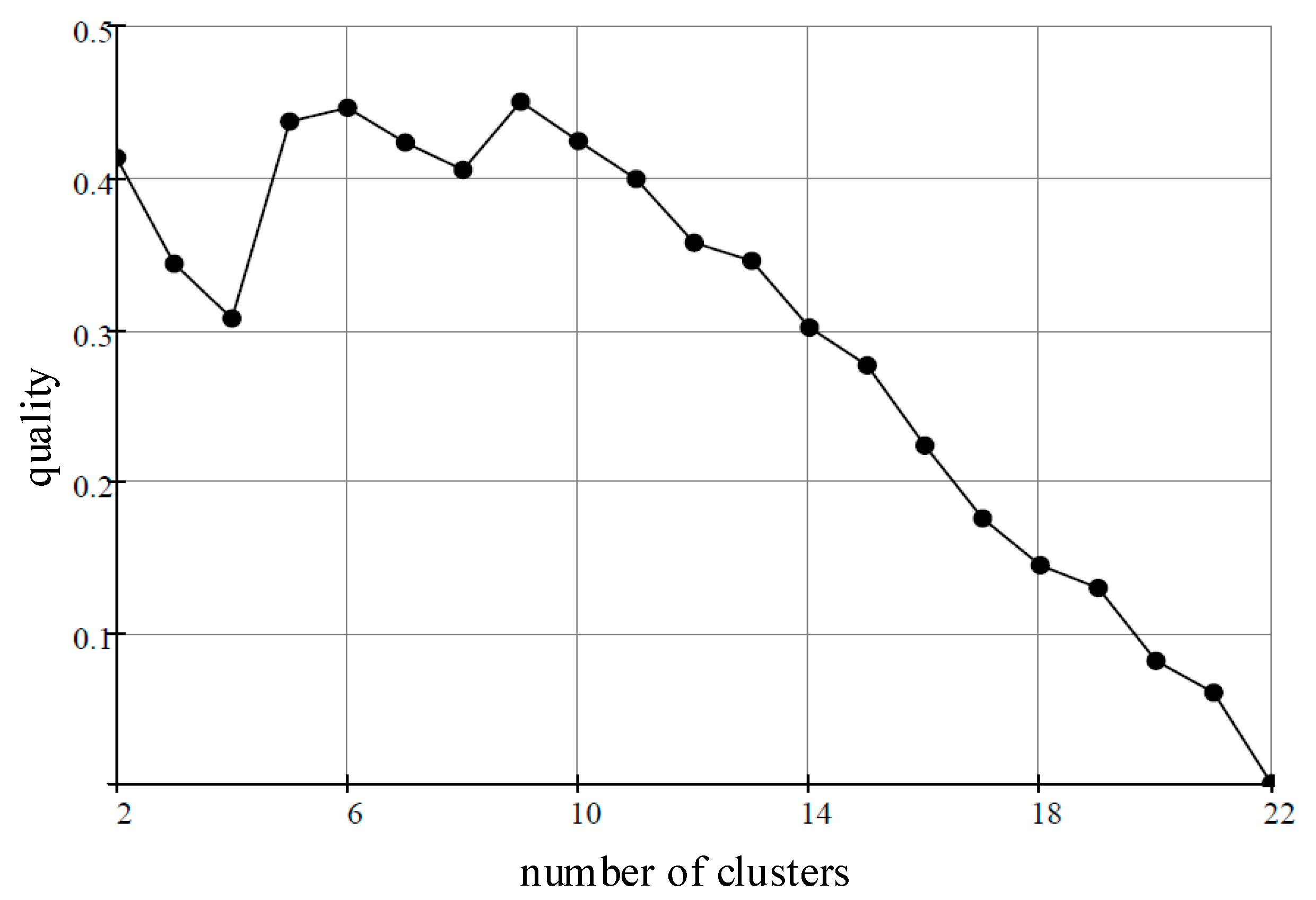
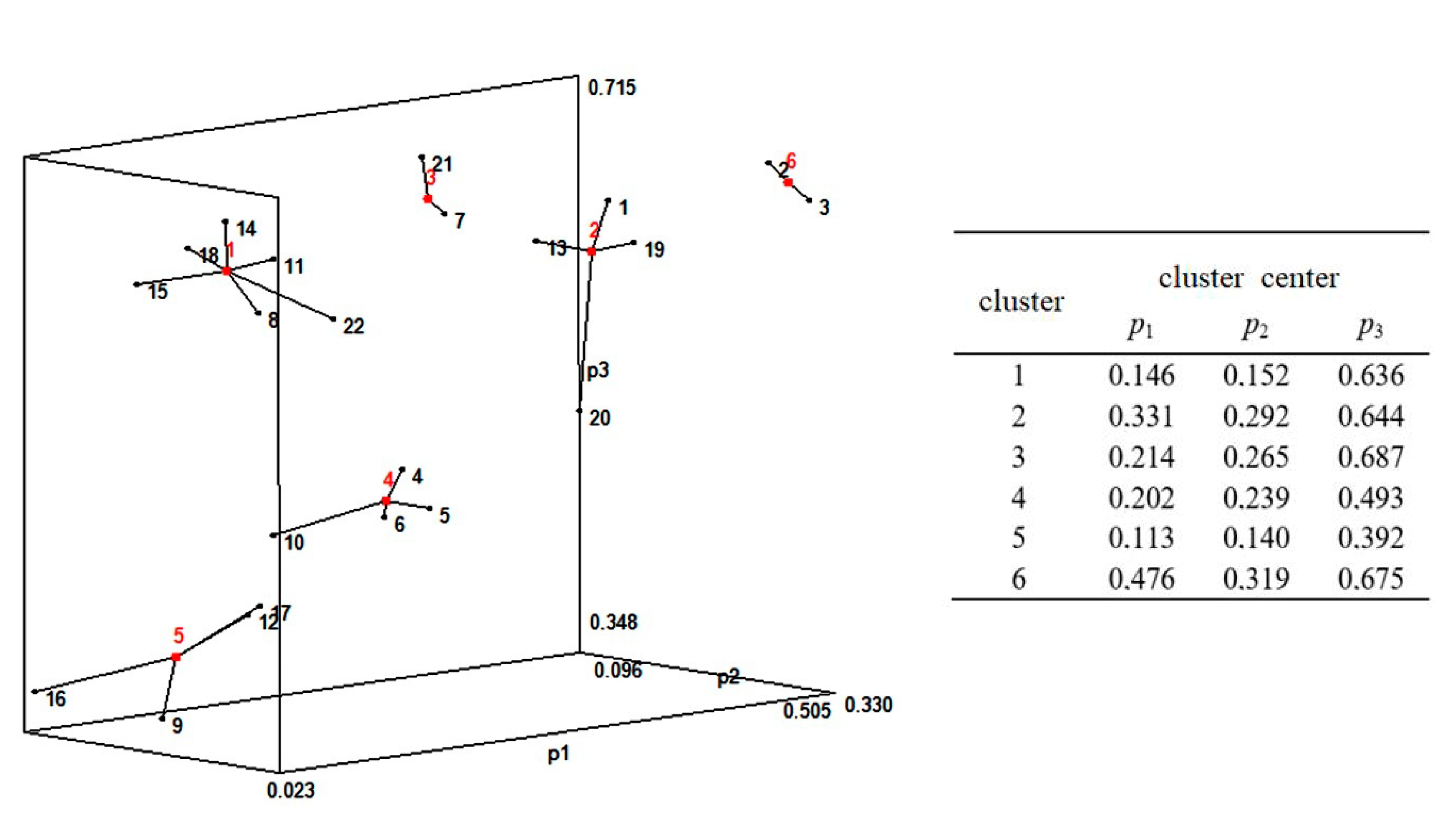


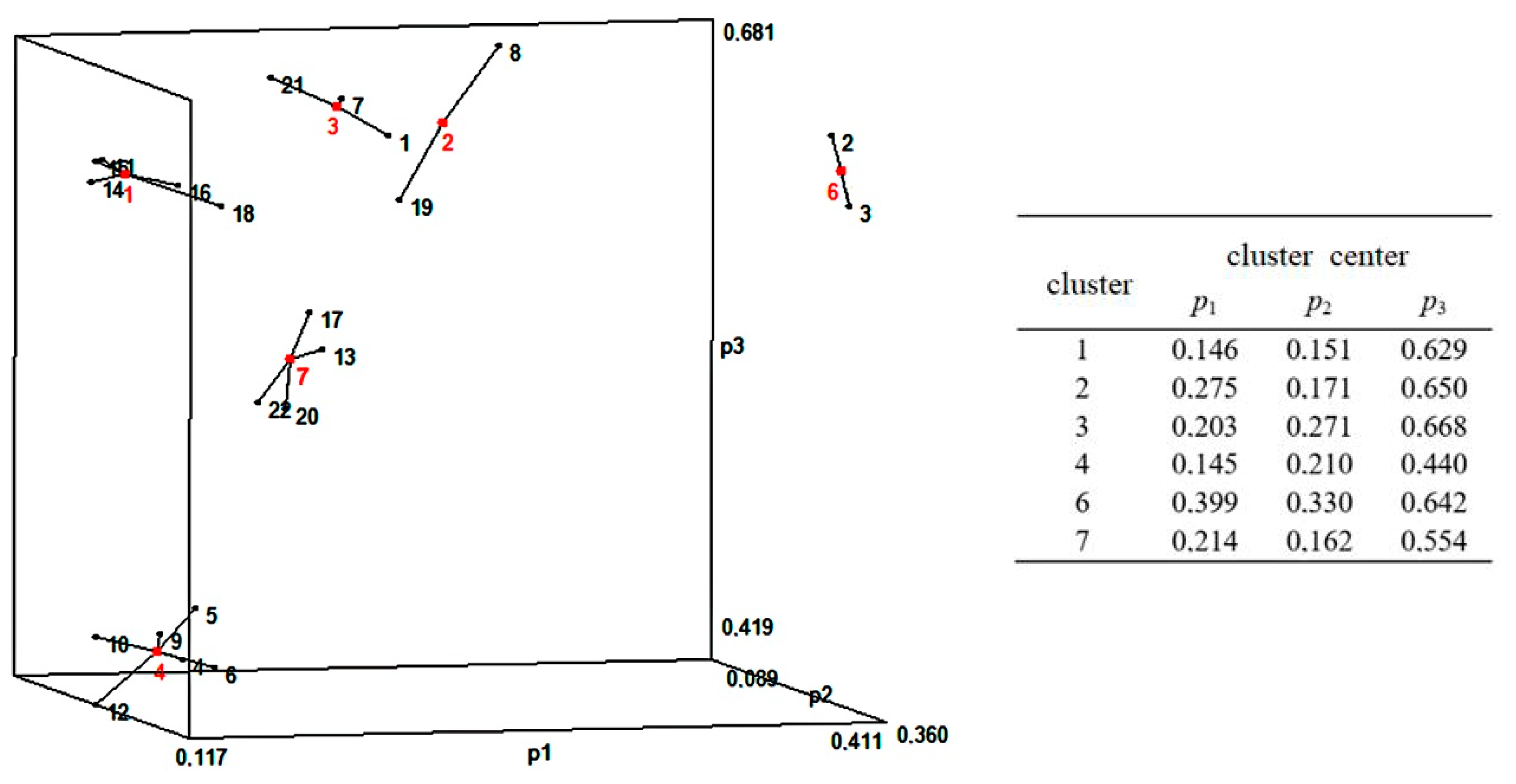

| Objects of the Energy System | Desnogorsk Energy College | The Branch of NRU “MPEI” in Smolensk | Smolensk NPP | Smolenskaya GRES | Smolensk TPP-2 | Dorogobuzhskaya TETS | Smolenskteploset | Dorogobuzh Thermal Management | GIDROSTROY | Firm Energo+ | Turbopar | Energomontazhavtomatika-EP | Analitpribor | ABO Valves | Stroykomplekt-Emal | Globus-Services | TD “Automation” | Dorogobuzhkotlomash | Smolenskenergo | Branch “Smolenskenergosbyt” | RUSELPROM-FEZ | Energoprommarket |
|---|---|---|---|---|---|---|---|---|---|---|---|---|---|---|---|---|---|---|---|---|---|---|
| a1 | a2 | a3 | a4 | a5 | a6 | a7 | a8 | a9 | a10 | a11 | a12 | a13 | a14 | a15 | a16 | a17 | a18 | a19 | a20 | a21 | a22 | |
| 0.329 | 0.448 | 0.505 | 0.218 | 0.209 | 0.215 | 0.230 | 0.145 | 0.123 | 0.137 | 0.143 | 0.142 | 0.334 | 0.145 | 0.122 | 0.023 | 0.162 | 0.162 | 0.351 | 0.284 | 0.202 | 0.172 | |
| 0.309 | 0.330 | 0.307 | 0.237 | 0.272 | 0.223 | 0.263 | 0.183 | 0.114 | 0.204 | 0.199 | 0.175 | 0.237 | 0.153 | 0.096 | 0.106 | 0.165 | 0.099 | 0.309 | 0.330 | 0.271 | 0.223 | |
| 0.678 | 0.692 | 0.659 | 0.512 | 0.491 | 0.480 | 0.675 | 0.612 | 0.348 | 0.474 | 0.649 | 0.420 | 0.645 | 0.667 | 0.623 | 0.376 | 0.422 | 0.643 | 0.649 | 0.552 | 0.715 | 0.610 |
| Clus-ters | Objects | |||||||||||||||||||||
|---|---|---|---|---|---|---|---|---|---|---|---|---|---|---|---|---|---|---|---|---|---|---|
| a1 | a2 | a3 | a4 | a5 | a6 | a7 | a8 | a9 | a10 | a11 | a12 | a13 | a14 | a15 | a16 | a17 | a18 | a19 | a20 | a21 | a22 | |
| 1 | 0.005 | 0.004 | 0.005 | 0.011 | 0.024 | 0.022 | 0.031 | 0.022 | 0.875 | 0.277 | 0.010 | 0.752 | 0.019 | 0.019 | 0.016 | 0.680 | 0.681 | 0.007 | 0.005 | 0.055 | 0.038 | 0.011 |
| 2 | 0.035 | 0.908 | 0.930 | 0.004 | 0.008 | 0.005 | 0.055 | 0.009 | 0.008 | 0.019 | 0.005 | 0.010 | 0.084 | 0.011 | 0.005 | 0.021 | 0.013 | 0.003 | 0.050 | 0.097 | 0.063 | 0.006 |
| 3 | 0.917 | 0.060 | 0.038 | 0.010 | 0.020 | 0.011 | 0.317 | 0.024 | 0.014 | 0.041 | 0.016 | 0.019 | 0.721 | 0.028 | 0.011 | 0.035 | 0.025 | 0.008 | 0.902 | 0.348 | 0.248 | 0.021 |
| 4 | 0.014 | 0.010 | 0.010 | 0.947 | 0.899 | 0.928 | 0.102 | 0.052 | 0.051 | 0.452 | 0.023 | 0.138 | 0.059 | 0.035 | 0.020 | 0.106 | 0.181 | 0.011 | 0.016 | 0.294 | 0.098 | 0.043 |
| 5 | 0.010 | 0.007 | 0.007 | 0.010 | 0.017 | 0.013 | 0.110 | 0.202 | 0.027 | 0.090 | 0.091 | 0.039 | 0.044 | 0.604 | 0.888 | 0.085 | 0.049 | 0.932 | 0.010 | 0.067 | 0.142 | 0.048 |
| 6 | 0.019 | 0.010 | 0.010 | 0.019 | 0.032 | 0.021 | 0.386 | 0.692 | 0.025 | 0.121 | 0.855 | 0.042 | 0.075 | 0.303 | 0.060 | 0.073 | 0.051 | 0.039 | 0.017 | 0.139 | 0.412 | 0.870 |
Publisher’s Note: MDPI stays neutral with regard to jurisdictional claims in published maps and institutional affiliations. |
© 2021 by the authors. Licensee MDPI, Basel, Switzerland. This article is an open access article distributed under the terms and conditions of the Creative Commons Attribution (CC BY) license (https://creativecommons.org/licenses/by/4.0/).
Share and Cite
Borisov, V.; Dli, M.; Vasiliev, A.; Fedulov, Y.; Kirillova, E.; Kulyasov, N. Energy System Monitoring Based on Fuzzy Cognitive Modeling and Dynamic Clustering. Energies 2021, 14, 5848. https://doi.org/10.3390/en14185848
Borisov V, Dli M, Vasiliev A, Fedulov Y, Kirillova E, Kulyasov N. Energy System Monitoring Based on Fuzzy Cognitive Modeling and Dynamic Clustering. Energies. 2021; 14(18):5848. https://doi.org/10.3390/en14185848
Chicago/Turabian StyleBorisov, Vadim, Maksim Dli, Artem Vasiliev, Yaroslav Fedulov, Elena Kirillova, and Nikolay Kulyasov. 2021. "Energy System Monitoring Based on Fuzzy Cognitive Modeling and Dynamic Clustering" Energies 14, no. 18: 5848. https://doi.org/10.3390/en14185848
APA StyleBorisov, V., Dli, M., Vasiliev, A., Fedulov, Y., Kirillova, E., & Kulyasov, N. (2021). Energy System Monitoring Based on Fuzzy Cognitive Modeling and Dynamic Clustering. Energies, 14(18), 5848. https://doi.org/10.3390/en14185848





